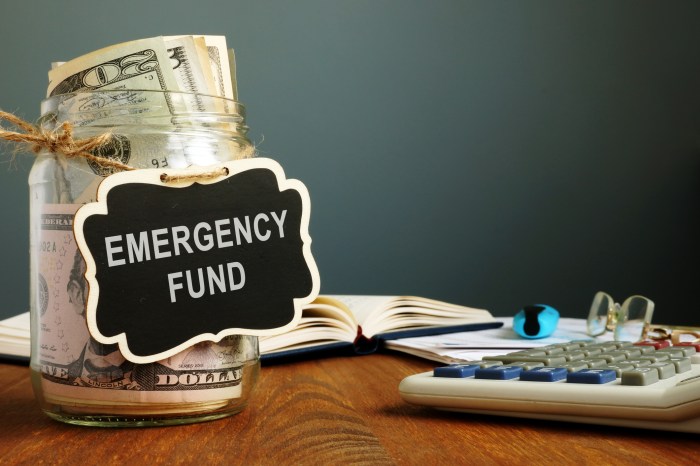Yo, peeps! Get ready to dive into the world of emergency savings where being financially prepared is the name of the game. We’re about to break down why having that emergency stash is key, how to set those savings goals, and even how to invest your funds like a boss. So, buckle up and let’s get this money talk started!
Now, let’s jump into the nitty-gritty details of why emergency savings are a must-have in your financial toolkit.
Importance of Emergency Savings
Saving for emergencies is crucial because life is unpredictable, and unexpected situations can arise at any time. Having a financial safety net in place can help you navigate through tough times without relying on high-interest loans or credit cards.
Common Emergencies Requiring Savings
- Medical emergencies: Unexpected health issues can lead to hefty medical bills that need to be paid immediately.
- Car repairs: Your vehicle breaking down can disrupt your daily routine and require a significant amount of money to fix.
- Job loss: Losing your source of income suddenly can be financially straining, and having savings can help cover your expenses while finding a new job.
Peace of Mind with Emergency Funds
Having savings set aside for emergencies provides a sense of security and peace of mind. Knowing that you have a financial cushion to fall back on in times of need can reduce stress and anxiety. It allows you to focus on finding solutions rather than worrying about how to make ends meet.
Setting Savings Goals

Saving for emergencies is crucial, but determining the appropriate amount to save can be challenging. Here are some tips to help you set effective savings goals.
Calculating Your Emergency Savings Goal
- Start by assessing your monthly expenses, including bills, groceries, and other necessities.
- Multiply your monthly expenses by the number of months you’d like to have saved up for emergencies (e.g., 3 to 6 months).
- Add any additional costs for unexpected expenses like medical emergencies or car repairs.
Realistic Emergency Savings Goals
Here are some examples of emergency savings goals based on different financial situations:
| Financial Situation | Emergency Savings Goal |
|---|---|
| Entry-level Job |
|
| Mid-level Career |
|
| High-Income Earner |
|
Building an Emergency Fund
Building an emergency fund is crucial for financial stability and peace of mind. It serves as a safety net during unexpected situations and helps prevent falling into debt.
Setting Aside a Percentage of Income
One effective strategy for building up your emergency fund is to set aside a percentage of your income regularly. This could be 10%, 20%, or any amount that fits your budget. Automating this process can make it easier to consistently contribute to your fund.
Importance of Consistency
Consistency is key when it comes to contributing to your emergency fund. Even small, regular contributions can add up over time and provide you with a solid financial cushion in case of emergencies. Make it a priority to contribute to your fund every month, no matter how small the amount.
Creative Ways to Cut Expenses
- Track your expenses: Keeping a close eye on where your money is going can help you identify areas where you can cut back.
- Cook at home: Eating out can be expensive, so try cooking meals at home to save money.
- Cancel subscriptions: Review your monthly subscriptions and consider canceling those that you don’t use frequently.
- Shop sales and use coupons: Look for deals and discounts when making purchases to save money.
- Find free or low-cost activities: Instead of spending money on expensive entertainment, look for free or low-cost activities in your area.
Investing Emergency Savings
Investing emergency savings is a crucial step in ensuring financial security and preparedness for unexpected expenses. While it is important to have easy access to emergency funds, exploring low-risk investment options can help these savings grow over time.
Importance of Liquidity
It is essential to keep emergency savings in a liquid and easily accessible form to ensure quick access in times of need. While investments offer the potential for higher returns, they may come with restrictions or penalties for early withdrawal, making them less suitable for emergency funds.
Low-Risk Investment Options
- High-Yield Savings Accounts: These accounts offer higher interest rates compared to traditional savings accounts, providing a safe and accessible option for emergency funds.
- Money Market Accounts: These accounts combine the benefits of a savings and checking account, offering higher interest rates while maintaining liquidity.
- Certificates of Deposit (CDs): CDs provide a fixed interest rate for a specific term, making them a low-risk option for emergency savings with the potential for higher returns.
Comparison of Savings Accounts and Investment Vehicles
| Criteria | Savings Accounts | Investment Vehicles |
|---|---|---|
| Liquidity | High | Varies (may have restrictions) |
| Risk | Low | Low to Moderate |
| Return | Low | Varies (potential for higher returns) |
